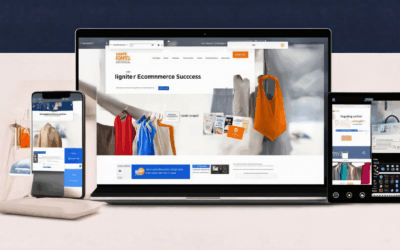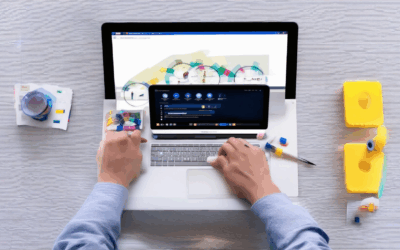In today’s fast-paced digital world, having a well-designed website is no longer optional—it’s essential for professionals looking to make a lasting impression and drive success. Whether you’re running a business, managing a brand, or working as a designer, crafting an effective online presence begins with a thoughtful and strategic website design process. This guide will walk you through the key steps, critical considerations, and best practices needed to create a website that not only reflects your brand identity but also delivers results. From aligning your design with business goals to ensuring a seamless user experience, we’ll explore everything you need to know to navigate the complexities of professional website design. By the end of this article, you’ll be equipped with the knowledge and tools to design a website that stands out, attracts visitors, and converts them into loyal customers or clients. Let’s dive in and uncover the secrets to creating an online presence that truly shines.
Key Takeaways
- Prioritize User Experience (UX) for seamless navigation and intuitive design.
- Focus on functionality to ensure robust performance and smooth interactions.
- Adopt a mobile-first approach for fully responsive and adaptive design.
- Utilize wireframes and prototypes for clear structure and efficient development.
- Integrate a tailored content strategy aligned with brand identity and SEO goals.
- Ensure cross-browser compatibility for universal accessibility and consistency.
- Monitor performance metrics for ongoing optimization and improved engagement.
- Design with SEO in mind to enhance search engine visibility and organic traffic.
- Address communication gaps with clear agreements and regular feedback loops.
- Balance creativity with client expectations through collaborative decision-making.
- Mitigate technical limitations by leveraging modern tools and testing across browsers.
- Manage time effectively using project management tools and prioritization techniques.
- Stay updated with design trends through continuous learning and industry engagement.
- Handle feedback constructively to foster growth and improve outcomes.
- Ensure SEO and UX compliance to drive performance and user satisfaction.
- Successfully collaborate with remote teams using clear protocols and collaboration tools.
- Enhance communication through client-designer agreements and regular check-ins.
- Educate clients early on design principles and best practices.
- Streamline processes with project management software and collaborative design tools.
- Stay curious and adaptable to embrace new trends and feedback.
- Cultivate a growth mindset to view challenges as opportunities for improvement.
- Integrate SEO and UX early in the process to maximize efficiency.
- Build strong relationships through understanding client goals and tailoring solutions.
- Clearly define goals and audience to tailor the design effectively.
- Craft a structured layout and content strategy aligned with brand values.
- Choose between custom or template-based designs suited to your needs.
- Develop a cohesive visual identity reflecting brand essence.
- Implement responsive design for universal device compatibility.
- Optimize user experience with intuitive navigation and fast loading times.
- Incorporate essential features to enhance user engagement.
- Thoroughly test across devices and browsers for reliability.
- Launch with analytics to monitor performance and gather feedback.
- Commit to continuous updates and improvements to maintain relevance.

Key Steps in the Website Design Process for Professionals
- Understanding Client Needs : Begin by conducting a thorough consultation with the client to understand their objectives, target audience, and specific requirements. This ensures the design aligns with their goals and expectations.
- Wireframing : Create a low-fidelity layout using tools like pen-and-paper or digital software. Focus on the placement of key elements such as navigation bars, content sections, and CTAs to establish the site’s structure.
- Visual Design : Develop detailed mockups that incorporate color schemes, typography, and overall aesthetics. This phase ensures the site is not only functional but also visually appealing and cohesive.
- Website Development : Transition wireframes and mockups into actual code. Choose appropriate technologies (e.g., HTML, CSS, JavaScript, CMS platforms) and ensure responsiveness for multi-device accessibility.
- Testing : Conduct rigorous testing to verify functionality, including form submissions, navigation, and user interactions. Perform user testing to gather feedback and identify usability issues.
- Deployment : Launch the website and transfer ownership to the client. Provide instructions for content updates and basic maintenance.
- Ongoing Support & Maintenance : Offer post-launch support, including content updates, bug fixes, and performance optimizations. Regularly monitor analytics to assess user behavior and SEO performance.
- Analytics & Feedback : Utilize tools like Google Analytics to track traffic and user engagement. Continuously gather user feedback to refine the site and enhance user experience.
By following these steps, professionals can deliver a well-structured, user-friendly, and visually appealing website tailored to meet client needs.
What Are the Critical Considerations When Designing a Professional Website?
Here are the key factors to consider when creating a professional website:
- User Experience (UX)
- Ensure the site is easy to navigate with clear menus and intuitive design.
- Focus on fast loading times and smooth transitions.
- Provide a seamless mobile experience due to the increasing use of mobile devices.
-
Visual Appeal and Branding
- Maintain a consistent color scheme and typography that aligns with your brand identity.
- Use high-quality images and graphics to enhance visual appeal.
- Incorporate responsive design principles to adapt to different screen sizes.
-
Content Strategy
- Develop a content plan that includes valuable and relevant information for your audience.
- Optimize content for search engines by incorporating keywords naturally.
- Regularly update content to keep it fresh and engaging.
-
Navigation and Structure
- Create a logical navigation menu that helps users find information quickly.
- Organize content into clear categories or sections for better usability.
- Use breadcrumbs to aid users in understanding their location within the site.
-
Performance Optimization
- Compress images and optimize code to reduce page load times.
- Implement caching mechanisms to improve speed.
- Use reliable hosting services to ensure uptime and fast delivery.
-
Legal Considerations
- Include a privacy policy and terms of service to build trust with visitors.
- Ensure compliance with accessibility standards to accommodate users with disabilities.
- Secure sensitive data through proper encryption methods.
-
Cross-Browser Compatibility
- Test the website across different browsers (Chrome, Firefox, Safari, etc.) to ensure compatibility.
- Fix any display issues that may arise from browser differences.
-
SEO (Search Engine Optimization)
- Research keywords relevant to your niche and incorporate them naturally into content.
- Optimize meta tags and alt texts for better search engine visibility.
- Build quality backlinks from authoritative sites to boost domain authority.
-
Accessibility
- Make sure the website is accessible to users with disabilities, including screen readers.
- Provide alternative text for images and ensure keyboard navigation works properly.
-
Branding Consistency
- Maintain a cohesive look and feel across all pages.
- Use consistent fonts, colors, and layout styles throughout the site.
-
Mobile-First Design
- Prioritize mobile users by designing the site to work flawlessly on smaller screens.
- Use touch-friendly buttons and ensure that forms are easy to complete on mobile devices.
By considering these factors, you can create a professional website that is both visually appealing and functionally robust, catering to a broad audience while meeting modern design standards.

Best Practices for Website Design Professionals
Websites are the digital face of businesses, making it crucial for designers to create impactful and functional online presences. Here are proven strategies to excel:
- User-Centric Design:** Prioritize intuitive navigation, seamless user experiences, and accessible interfaces. Ensure your designs cater to diverse audiences, including those with disabilities.
- Mobile Responsiveness:** Optimize for all screen sizes. Mobile users account for over half of global traffic, so prioritize responsive layouts and touch-friendly interfaces.
- Fast Load Times:** Implement lazy loading, compress images, and minimize code to reduce load times, boosting both user satisfaction and SEO rankings.
- SEO Integration:** Embed meta tags, optimize images with alt texts, and structure content with semantic HTML. This improves search engine visibility and user engagement.
- Content Strategy:** Develop high-quality, relevant content that aligns with audience needs. Use blogs, case studies, and FAQs to drive engagement and establish authority.
- Performance Tuning:** Regularly audit your site for broken links, cached files, and outdated plugins. A clean, optimized codebase enhances speed and reliability.
- Accessibility Compliance:** Ensure your design meets WCAG standards. Provide closed captions, alt texts for images, and keyboard navigation options for users with disabilities.
- Cross-Device Compatibility:** Test your design across various devices and browsers to ensure consistency. Use CSS frameworks like Bootstrap or Tailwind CSS for broader compatibility.
- Consistent Branding:** Maintain uniform typography, colors, and spacing to reinforce brand identity. Use style guides to ensure consistency across all platforms.
- Analytics and Feedback:** Implement Google Analytics and gather user feedback through surveys or live chat. Use data to refine design decisions and improve user experience.
- Stay Updated with Trends:** Keep abreast of design trends like AI-driven tools, voice search optimization, and sustainable design practices to remain competitive.
By following these guidelines, website design professionals can create visually appealing, functional, and conversion-driven websites that resonate with their target audience.

What Makes the Website Design Process for Professionals Effective?
The effectiveness of a website design process for professionals depends on several critical factors:
- User Experience (UX):
A professional website design prioritizes user experience, ensuring the site is intuitive, accessible, and enjoyable for all visitors. We focus on creating seamless navigation, logical layout, and visually appealing interfaces that align with the brand identity while meeting user needs. - Functionality:
Beyond aesthetics, functionality is the backbone of an effective website design. Key features include robust coding, smooth animations, and full responsiveness across devices. Our team ensures the site performs optimally, supporting all necessary interactions without lag or errors. - Responsive Design:
Mobile-first design has become essential, with websites needing to adapt seamlessly to desktops, tablets, and mobile phones. We employ flexible layouts and media queries to deliver a consistent experience, optimizing for all screen sizes. - Wireframing and Prototyping:
Early-stage tools like wireframes and prototypes allow us to visualize the site’s structure before development. This iterative approach helps identify potential issues early, ensuring the final product meets both aesthetic and functional goals. - Content Strategy Integration:
Effective website design incorporates a well-thought-out content strategy. We work closely with clients to define their messaging, structure content logically, and optimize it for search engines, ensuring it resonates with the target audience. - Cross-Browser Compatibility:
Ensuring compatibility across major browsers like Chrome, Firefox, Safari, and Edge is crucial. We test designs thoroughly to eliminate display issues, ensuring consistency regardless of the platform. - Analytics and Performance Optimization:
Post-launch, we monitor performance metrics to identify areas for improvement. By tracking user behavior and load times, we fine-tune the design for better engagement and faster loading speeds. - SEO-Friendly Design:
Incorporating SEO best practices into the design phase ensures the site ranks well in search engine results. Elements like meta tags, alt text, and structured data are integrated to boost visibility and drive organic traffic.
For further insights, explore our comprehensive guide on Effective Website Design , which delves into these topics and provides actionable strategies for achieving success online. Additionally, discover how Smashing Magazine and Awwwards showcase innovative approaches to web design. Lastly, learn about HubSpot ’s frameworks for creating high-performing websites.
Unique Challenges Faced by Professionals in the Website Design Process
- Communication Gaps: One of the most common challenges is the misalignment between client expectations and designer deliverables. Clients often lack the technical jargon to articulate their vision, leading to misunderstandings about the final product.
- Balancing Creativity with Client Expectations: Designers must navigate the fine line between pushing creative boundaries and meeting the client’s specific demands. This can sometimes lead to conflicts if the client’s vision doesn’t align with the designer’s artistic approach.
- Technical Limitations: Many clients operate with outdated tools or lack access to modern technologies, which can hinder the design process and result in suboptimal outcomes. Additionally, ensuring cross-browser compatibility remains a persistent challenge due to varying browser versions.
- Time Management: Juggling multiple projects, tight deadlines, and client demands can overwhelm even experienced designers. Effective project management tools and prioritization techniques are essential to stay ahead of the curve.
- Staying Updated with Trends: The digital landscape evolves rapidly, requiring constant learning and adaptation. Designers must invest time in staying informed about the latest trends, tools, and technologies to remain competitive.
- Handling Client Feedback: Negative feedback can be disheartening, especially if it feels personal. Designers must develop a thick skin and view constructive criticism as a tool for growth rather than a reflection of their abilities.
- Ensuring SEO and UX Compliance: While many clients recognize the importance of SEO and user experience, others may underestimate its impact. Ignoring these aspects can lead to poor site performance and lost opportunities.
- Working with Remote Teams: Collaborating with distributed teams introduces complexities in managing timelines, ensuring alignment, and maintaining consistent communication. Clear protocols and collaboration tools are vital for success.
Solutions to Overcome These Challenges
- Improve Communication: Use client-designer agreements and regular check-ins to align expectations. Provide clients with visual aids and ask probing questions to ensure clarity.
- Educate Clients Early: Share resources and educate clients about design principles, allowing them to make informed decisions. This builds trust and ensures everyone is on the same page.
- Leverage Tools: Utilize project management software like Trello or Asana to organize tasks and deadlines. Use design tools that offer version control and collaboration features to streamline the process.
- Stay Curious and Adaptive: Continuously seek out new knowledge through workshops, online courses, and industry forums. Embrace feedback as a means to refine your approach and deliver better results.
- Foster a Growth Mindset: View challenges as opportunities to learn and improve. Surround yourself with peers who encourage experimentation and innovation.
- Integrate SEO and UX Early: Educate clients on the importance of SEO and UX from the outset. Conduct usability tests and provide analytics-driven insights to justify design decisions.
- Build Strong Relationships: Invest time in building rapport with clients. Understanding their goals and pain points can help tailor your approach and deliver a solution that truly meets their needs.
For more insights and resources on mastering the website design process, visit 119WebDesign.com .

What Are the Key Steps in the Website Design Process for Professionals to Create an Effective Online Presence?
Here’s a breakdown of the essential steps involved in designing an effective website for professionals:
- Define Your Goals and Target Audience
- Begin by understanding what your website aims to achieve, whether it’s promoting a product, showcasing services, or building a community.
- Identify your target audience and tailor the design to meet their needs and preferences.
- Plan the Structure and Content
- Outline the website’s layout, including the main sections like Home, About Us, Services, Portfolio, and Contact.
- Create a content strategy that aligns with your brand identity and communicates your unique value proposition effectively.
- Choose a Design Approach
- Decide between a custom website built from scratch or a template-based solution that fits your requirements.
- Select a design style that reflects your brand—minimalist, modern, or vibrant—and ensures optimal user experience.
- Develop the Visual Identity
- Design a logo, color scheme, typography, and overall visual branding that resonate with your audience.
- Ensure consistency across all elements to create a cohesive look and feel.
- Implement Responsive Design
- Optimize the website for all devices, including desktops, tablets, and mobile phones, to ensure accessibility and usability across platforms.
- Use flexible layouts and media queries to adapt content dynamically based on screen size.
- Optimize for User Experience (UX)
- Simplify navigation to make it intuitive and easy to use.
- Focus on creating smooth transitions, fast loading times, and a seamless browsing experience.
- Integrate Necessary Features
- Include essential features like contact forms, social media integration, e-commerce functionality, or a portfolio section.
- Use high-quality images, videos, and interactive elements to enhance engagement.
- Test and Refine
- Conduct thorough testing across different browsers and devices to identify and fix any issues.
- Gather feedback from users and make necessary adjustments to improve functionality and aesthetics.
- Launch and Monitor Performance
- Deploy the website to your hosting server and ensure it goes live without errors.
- Set up analytics tools to track traffic, user behavior, and conversion rates.
- Continuous Improvement
- Regularly update the website with new content, features, and design trends to keep it relevant and competitive.
- Engage with your audience through blog posts, social media interactions, and customer support to foster loyalty and trust.
By following these steps, you can create a professional-grade website that not only looks great but also drives results and builds a strong online presence.




0 Comments